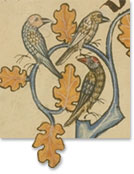|

The main focus of this exercise
is on the use of historical
sources. Pupils are presented
with a problem in the murder
of Becket. They are presented
with a range of possible explanations
and they are also presented
with a range of sources. The
aim is to use the sources
to decide which of the explanations
seems most plausible in the
light of the available source
material and to use the sources
as evidence to substantiate
this judgement.
The
introductory page is designed
to give the pupils some sort
of grounding. Pupils may not
have heard of Becket, and
are also unlikely to be familiar
with the concept of pilgrimage.
It may be useful to discuss
contemporary examples as a
way to introduce the topic.
Any high profile murder case
in the news should raise the
difficulty of determining
motive and evidence. In addition,
deaths of all kinds result
in memorials of one kind or
another. A good example of
a relatively recent set of
events like this is the Stephen
Lawrence murder with its repercussions.
The
next obvious point is the
narrative telling the story
of Henry's relationship with
Becket. Pupils can always
access this from whatever
part of the resource they
are studying. Teachers may
want pupils to simply read
through the text to get a
feel for the story. They may
want to read the text to pupils,
or use class reading with
a printed version of the story.
There
are a number of signposts
within the narrative which
pupils need to look out for.
 |
Section
1 gets across the
point that the church
was powerful and that
the church and state were
integral parts of the
same whole. |
 |
Section
2 develops the point
that Henry and Becket
were friends, but that
Henry had had his differences
with the church. |
 |
Section
3 charts the increasing
tension between Henry
and Becket. Pupils could
be encouraged to look
here for evidence to support
one of the explanations
put forward in the introduction.
|
 |
Section
4 describes the murder
and the confusion surrounding
it. Again, it is a good
platform for some initial
hypothesising about the
views on Becket's murder.
|
 |
Section
5 assesses the impact
of the murder on popular
opinion. In doing so it
again raises the opportunity
to consider Becket's reputation
and thereby the validity
of the three views on
his death. |
From
the narrative, pupils should
study the sources. Teachers
may want to divide the class
into groups and allocate them
one or two sources. Some are
long and rather involved.
The image sources in particular
need a lot of careful 'decoding'
to strip away the messages
they are attempting to convey.
It
may prove worthwhile to add
in an additional activity
in which each group gives
a short presentation on their
source. This presentation
should describe what pupils
learnt from it but also what
reservations they may have
about it. In the case of picture
sources, they could use desktop
publishing software to annotate
a copy of the source. For
the text sources, pupils could
use word processing software
to highlight sections of text
which raise important points.
Whatever
methods used, pupils need
to consider issues such as:
 |
Date
and context of the source |
 |
The
author and intended audience
of the source |
 |
The
purpose of the source
|
Much
good work has been done with
sources in history classrooms
by asking pupils to consider
whether the most appropriate
phrases to be used with a
source are:
 |
The
source tells me that … |
 |
The
source suggest that … |
 |
From
the source I can infer
that …
|
From
this platform the class could
come together and complete
the table in stage 1. Teacher
guidance is important here
in encouraging pupils to be
brief and precise about the
content of the source and
its relevance to the main
issue - the appropriateness
or otherwise of the three
views.
Stage
2 of the task sheet provides
pupils with a pro forma 'writing
frame' for pupils to write
up their final conclusions.
It should be stressed that
this is merely a framework
and should not be used without
the preliminary work with
the table in stage 1 and ideally
the group discussions on the
sources. There is a danger
that writing frames without
the extensive prior work can
mask a lack of understanding
in many pupils.
A
final consideration which
teachers may want to consider
is that the exercise could
be given a stronger focus
on the issue of interpretations,
particularly by concentrating
on the date of the sources
and the possible ways in which
the accounts, when arranged
chronologically, may have
influenced each other. The
images are very much post
hoc accounts feeding the story
of Becket as martyr, whereas
the secondary source very
much contradicts this view.
The opportunity exists here
to consider that issue as
an introduction for pupils
into the issue of historical
interpretations.
|